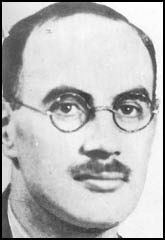Name Alan May Role Physicist | ||
 | ||
Died January 12, 2003, Cambridge | ||
Alan Nunn May (2 May 1911 – 12 January 2003) was a British physicist, and a confessed and convicted Soviet spy, who supplied secrets of British and United States atomic research to the Soviet Union during World War II.
Contents
- Early years education
- Early Communist ties
- World War II
- Soviet espionage
- Convicted of espionage
- Personal and death
- Legacy
- References

Early years, education
Nunn May was the son of a brassfounder, born in Kings Norton, Birmingham, and educated at King Edward's School, Birmingham. As a scholarship student at Trinity Hall, Cambridge, he achieved a first in physics, which led to doctoral studies under Charles Ellis and lectureship at King's College London.
Early Communist ties
Nunn May joined the Communist Party of Great Britain in the 1930s, and was active in the Association of Scientific Workers. Cambridge Five spy ring member Donald Duart Maclean was also at Trinity Hall during an overlapping period.
World War II
During World War II, he initially worked on radar in Suffolk, then with Cecil Powell in Bristol on a project that attempted to use photographic methods to detect fast particles from radioactive decay. James Chadwick recruited him to a Cambridge University team working on a possible heavy water reactor. The team was part of the British Tube Alloys directorate which was merged into the American Manhattan Project, the successful effort to create a nuclear weapon. In January 1943 the Cambridge team including Nunn May transferred to the Montreal Laboratory which was building a reactor at Chalk River near Ottawa, Ontario, Canada. His Canadian job ended in September 1945, and he returned to his lecturing post in London.
Soviet espionage
He had let his membership of the Communist Party lapse by 1940, but at Cambridge when he saw an American report mentioning that Germany might be able to build a dirty bomb, he passed this on to a Soviet contact. In Canada he was approached by Lieutenant Angelov of the GRU (Soviet military intelligence) for information on atomic research. He continued his espionage by secretly supplying small samples of the isotopes Uranium-233 and 235. The courier of these samples was not informed of the danger of radiation and developed painful lesions. He subsequently needed lifelong regular blood transfusions. May also borrowed library research documents on nuclear power, many from the USA, for copying. The Canadian Royal Commission which later investigated said he was paid with two bottles of whiskey and at least $700 (Canadian); Nunn May said he accepted the money under protest and promptly burnt it. Angelov gave him details for a rendezvous with the GRU next to the British Museum in London after his return.
Convicted of espionage
A GRU cipher clerk in Canada, Igor Gouzenko, defected to the West in Ottawa in September 1945; this was right around the time when Nunn May's Canadian assignment ended. Gouzenko passed along copies of GRU documents implicating Nunn May, including details of the proposed meeting in London. Nunn May did not go to the British Museum meeting, but he was arrested in March 1946. Nunn May confessed to espionage. On 1 May 1946, he was sentenced to ten years hard labour. He was released in late 1952, after serving six and a half years.
May refused to define his actions as treason, claiming in a statement after his release from prison that he believed he had "acted rightly" and had acted as a spy because of being "wholeheartedly concerned with securing victory over Nazi Germany and Japan, and the furtherance of the development of the peaceful uses of atomic energy."
Blacklisted from universities in Britain, Nunn May worked for a scientific instruments company, then in 1961 went to work at the University of Ghana, where he conducted research in solid-state physics and created a science museum.
Personal and death
Nunn May's first name is sometimes spelled Allan with two L's, but the Oxford Dictionary of National Biography and the Encyclopædia Britannica both use Alan.
In 1953, Nunn May married Hilde Broda, ex-wife of Engelbert Broda. They had a son, and a stepson from Hilde's previous marriage.
He returned to Cambridge in 1978, and died there in a hospital on 12 January 2003. Cause of death was pneumonia and pulmonary disease.
A 2002 statement released after his death stated that he had no regrets about his spying activities. It was passed to The Guardian newspaper in 2003 having been dictated to a relative in late 2002.
Legacy
Nunn May's arrest and sentence in 1946 first showed publicly that the Soviet Union had obtained atomic secrets by espionage. His clearance by MI5 also led to American distrust of Britain, and the McMahon Act. He passed on information on atomic reactors, but unlike Klaus Fuchs (who was arrested in 1950) he knew little of weapon design.
Nunn May is a major character in the 2003 novel The Cloud Chamber, by Clare George, a fictional account of Cambridge physicists in the 1930s which centres on the scientific excitement of the interwar years contrasted with the vexing moral questions faced by scientists during World War II. The main character is a fictional physicist and pacifist who studied and worked at Cambridge's Cavendish Laboratory with Nunn May before the war. George's acknowledged inspiration for the story was her grandfather, a real-life physicist whose true story follows several of the particulars of her character, Walter Dunnachie.
